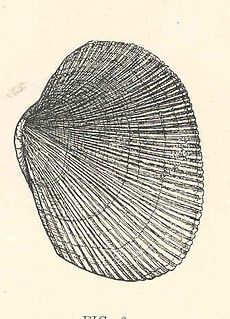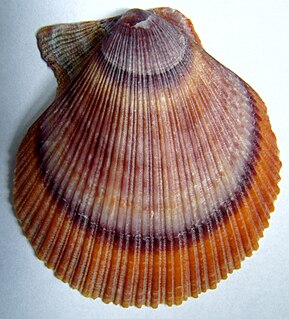Related Research Articles

The Apicomplexa are a large phylum of parasitic alveolates. Most of them possess a unique form of organelle that comprises a type of plastid called an apicoplast, and an apical complex structure. The organelle is an adaptation that the apicomplexan applies in penetration of a host cell.
Perkinsus marinus is a species of alveolates belonging to the phylum Perkinsozoa. It is similar to a dinoflagellate. It is known as a prevalent pathogen of oysters, causing massive mortality in oyster populations. The disease it causes is known as dermo or perkinsosis, and is characterized by the degradation of oyster tissues. The genome of this species has been sequenced.
Perkinsus is a genus of alveolates in the phylum Perkinsozoa. The genus was erected in 1978 to better treat its type species, Perkinsus marinus, known formerly as Dermocystidium marinum. These are parasitic protozoans that infect molluscs, at least some of which cause disease and mass mortality. P. marinus is the most notorious, causing the disease perkinsosis, or dermo, in wild and farmed oysters.

The hard clam, also known as a quahog, round clam or hard-shellclam, is an edible marine bivalve mollusk that is native to the eastern shores of North America and Central America from Prince Edward Island to the Yucatán Peninsula. It is one of many unrelated edible bivalves that in the United States are frequently referred to simply as clams, as in the expression "clam digging". Older literature sources may use the systematic name Venus mercenaria; this species is in the family Veneridae, the venus clams.

The ocean quahog is a species of edible clam, a marine bivalve mollusk in the family Arcticidae. This species is native to the North Atlantic Ocean, and it is harvested commercially as a food source. This species is also known by a number of different common names, including Icelandic cyprine, mahogany clam, mahogany quahog, black quahog, and black clam.

Leukoma staminea, commonly known as the Pacific littleneck clam, the littleneck clam, the rock cockle, the hardshell clam, the Tomales Bay cockle, the rock clam or the ribbed carpet shell, is a species of bivalve mollusc in the family Veneridae. This species of mollusc was exploited by early humans in North America; for example, the Chumash peoples of Central California harvested these clams in Morro Bay approximately 1,000 years ago, and the distinctive shells form middens near their settlements.

Chlamys is a genus of small scallops, marine bivalve molluscs in the family Pectinidae. The name is taken from the Ancient Greek, χλαμΰς or Chlamys, a cloak worn by soldiers.

Scallop aquaculture is the commercial activity of cultivating (farming) scallops until they reach a marketable size and can be sold as a consumer product. Wild juvenile scallops, or spat, were collected for growing in Japan as early as 1934. The first attempts to fully cultivate scallops in farm environments were not recorded until the 1950s and 1960s. Traditionally, fishing for wild scallops has been the preferred practice, since farming can be expensive. However worldwide declines in wild scallop populations have resulted in the growth of aquaculture. Globally the scallop aquaculture industry is now well established, with a reported annual production totalling over 1,200,000 metric tonnes from about 12 species. China and Japan account for about 90% of the reported production.

Chlamys islandica, the Iceland scallop, is a species of bivalve mollusc in the family Pectinidae. This North Atlantic scallop attaches itself to hard surfaces such as rocks and can be found from the intertidal zone to a depth of 200 m (660 ft).
Aggregata is a genus of parasitic alveolates belonging to the phylum Apicomplexa.
Defretinella is a genus of parasitic alveolates of the phylum Apicomplexa.

Klossiella is a genus of parasitic alveolates of the phylum Apicomplexa. Species in this genus infect the renal tract of mammals and intestinal tract of snakes.
Pseudoklossia is a genus in the phylum Apicomplexa. Species in this genus infect marine molluscs, although one species infects in an ascidian worm. The life cycle is heteroxenous.
Veloxidium is a genus of parasitic alveolates in the phylum Apicomplexa. Species in this genus infect marine invertebrates.
The Platyproteum are a genus of parasitic alveolates in the phylum Apicomplexa. Species in this genus infect marine invertebrates.
Meroselenidium is a genus of parasitic alveolates in the phylum Apicomplexa. Species in this genus infect marine invertebrates.
Lipocystis is a genus of parasitic alveolates of the phylum Apicomplexa.
Coccidinium is a genus of parasitic syndinian dinoflagellates that infect the nucleus and cytoplasm of other marine dinoflagellates. Coccidinium, along with two other dinoflagellate genera, Amoebophyra and Duboscquella, contain species that are the primary endoparasites of marine dinoflagellates. While numerous studies have been conducted on the genus Amoebophyra, specifically Amoebophyra ceratii, little is known about Coccidinium. These microscopic organisms have gone relatively unstudied after the initial observations of Édouard Chatton and Berthe Biecheler in 1934 and 1936.
Nematopsis (Nee-mah-top-cis) is a genus gregarine Apicomplexan of the family Porosporidae. It is an aquatic parasite of crustaceans with a molluscan intermediate host. Nematopsis has been distinguished from the similar genus Porospora by its resistant and encapsulated oocyst. Little molecular biology has been performed on the members of the Nemaptosis and species are described based on molluscan and crustacean hosts as well as oocyst structure. A total of 38 species have been described and are found all over the world.
Electrovermis zappum is a species of fish blood fluke discovered in the Gulf of Mexico and described in 2019. It has been placed in a new genus, Electrovermis. This parasite infects the lesser electric ray. Once it successfully invades the host, it migrates to and dwells in the lumen of the heart of the ray. Like other blood flukes, it thrives by feeding off of the blood of its host. The adults are morphologically and physiologically similar to other blood flukes that infect rays such as Orchispirium heterovitellatum. Unlike many other blood flukes that infect molluscs as an intermediate host, E. zappum infects bivalves such as clams. Both the rays and clams densely populate warm, shallow intertidal marine waters, which provide the parasite an opportunistic environment to carry out its life cycle stages.
References
- ↑ Desser SS, Bower SM (1997) Margolisiella kabatai gen. et sp. n. (Apicomplexa: Eimeriidae), a parasite of native littleneck clams, Protothaca staminea, from British Columbia, Canada, with a taxonomic revision of the coccidian parasites of bivalves (Mollusca: Bivalvia). Folia Parasitol (Praha) 44(4):241-247
- ↑ Kristmundsson Á, Helgason S, Bambir SH, Eydal M, Freeman MA (2011) Margolisiella islandica sp. nov. (Apicomplexa: Eimeridae) infecting Iceland scallop Chlamys islandica (Müller, 1776) in Icelandic waters. J Invertebr Pathol 108(3):139-146
| | This Apicomplexa-related article is a stub. You can help Wikipedia by expanding it. |